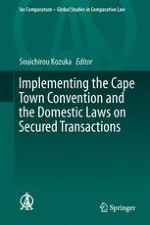2017 | OriginalPaper | Chapter
12. Finnish Mortgage System for Means of Transport: Outdated and Overly Complex?
Author : Teemu Juutilainen
Published in: Implementing the Cape Town Convention and the Domestic Laws on Secured Transactions
Publisher: Springer International Publishing
Activate our intelligent search to find suitable subject content or patents.
Select sections of text to find matching patents with Artificial Intelligence. powered by
Select sections of text to find additional relevant content using AI-assisted search. powered by
